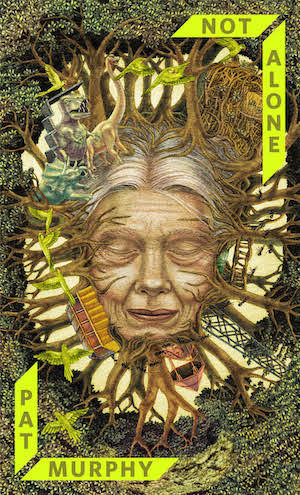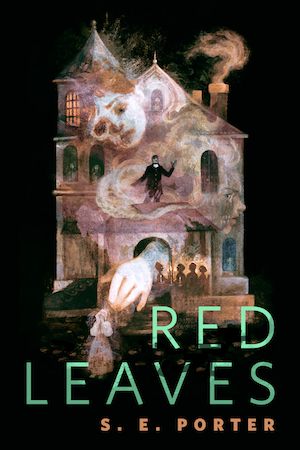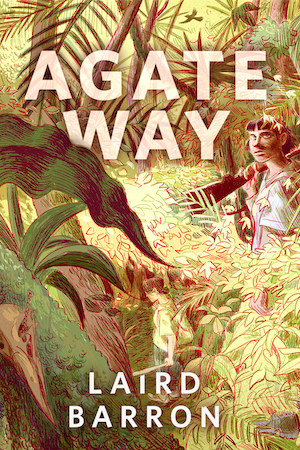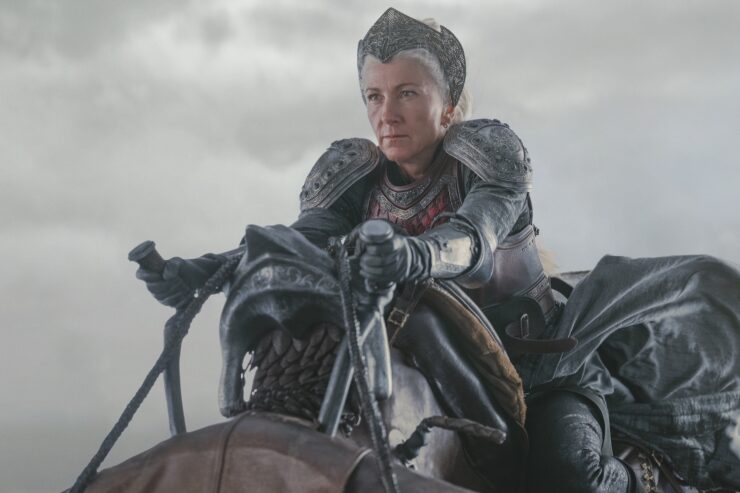We’re now halfway through House of the Dragon’s sophomore season and just past the first actual dragon battle of the titular Dance of the Dragons. We also have our biggest character death of the season thus far, and some exploration of the supernatural that has been largely missing from HotD up to this point. Let’s discuss the episode—there will be spoilers below—and how it adapts (and differs) from Martin’s original version of this story…
The Title
Episode four is titled “A Dance of Dragons.” (Note: Please see the update below…) In-world history remembers this Targaryen civil war as “the Dance of the Dragons,” so this first full-on dragon battle of the conflict is using the indefinite version of the name to signal that war truly has begun. Incidentally, the fifth book in Martin’s ASoIaF series references this, styling itself A Dance with Dragons. That book roughly corresponds to elements of seasons five and six of the original Game of Thrones series (though there was enough of a butterfly effect from changes in adaptation that large portions of it were never represented on the show) and takes “dance” slightly less euphemistically as it centers on the numerous Westerosi suitors who have traveled to Mereen to try and marry Daenerys Targaryen and benefit from her growing power.
Archmaester Gyldayn, Martin’s in-world author of Fire & Blood, chooses to refer to this period in Westerosi history as “the dying of the dragons” saying:
“The Dance of the Dragons” is a flowery name bestowed upon the savage internecine struggle for the Iron Throne of Westeros fought between two rival branches of House Targaryen during the years 129 to 131 AC. To characterize the dark, turbulent, bloody doings of this period as a “dance” strikes us as grotesquely inappropriate. No doubt the phrase originated with some singer. “The Dying of the Dragons” would be altogether more fitting, but tradition, time, and Grand Maester Munkun have burned the more poetic usage into the pages of history, so we must dance along with the rest. (Martin 391)
Martin’s hatred of war and his penchant for regularly calling attention to the ways in which warfare is (grotesquely) glorified seems to be something that the show is consciously playing with. The tapestries during the title sequence show public and often misremembered versions of events (no changes to them from the version we saw last week, incidentally). And now the episode titles use the language that Gyldayn hates. Despite the brutal slaughter, despite the pointless maiming and death, this is a “dance” to all the knights and maidens dreaming of glory in subsequent eras.
Update: Hey folks! They totally changed the episode title from what it was in my screener. The actual title of the episode is “The Red Dragon and the Gold.” It, obviously, refers to Meleys and Sunfyre, the two dragons who are either killed or maimed in the Battle of Rook’s rest. Colors see important to both of these dragons—Meleys is also called “The Red Queen” and Sunfyre is sometimes called “Sunfyre the Golden.” It’s a tribute to the first Dragon casualties of the Dance. Remember that, given the rarity of these beasts, their importance as symbols of House Targaryen, and the fact that the Dance of the Dragons is the event that all but makes dragons extinct—these casualties may matter more than the deaths of soldiers or, indeed, monarchs.
It’s also a symbolic recapitulation of the factions and the war itself. The Blacks’ standard features a red dragon. The Greens’ features a gold one. The Red Dragon and the Gold is a microcosm of the war itself, both in terms of what’s at stake and in how the Battle at Rook’s Rest is a Pyrrhic victory. To quote Rhaenyra from last episode, “even victory may be so bloody as to be counted a loss.” There aren’t going to be winners in this war. Black and Green, Red and Gold, all are headed for catastrophe.
Velaryon Sons
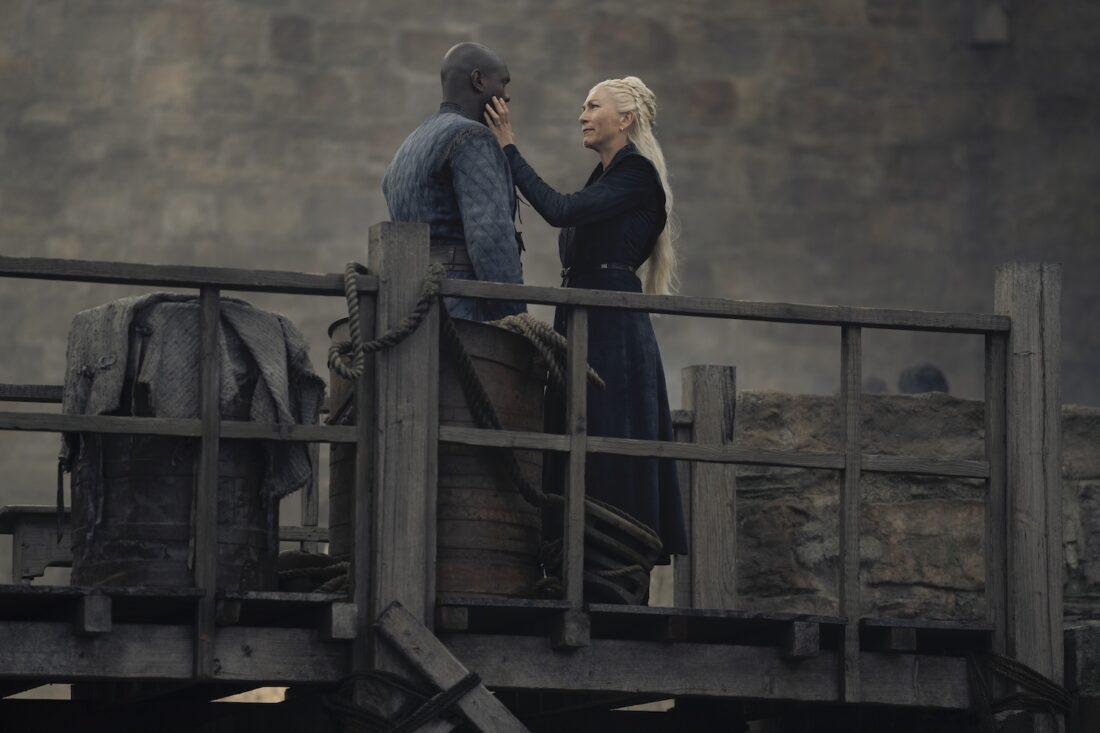
Rhaenys (Eve Best) approaches Alyn (Abubakar Salim) and, with despair in her voice, says that his mother must have been beautiful. This brings forward the subtext that the show has been dancing around—that Alyn (and Clinton Liberty’s Addam) are Corlys’ bastard sons. In Fire & Blood, the brothers are silver-haired and purple-eyed, making them clearly Valyrian. Gyldayn reports that, when they come to the attention of the Black council, they declare themselves to be “the natural sons of the late Laenor Velaryon” (Martin 442). But Gyldayn also notes, in the next paragraph, that “Laenor Velaryon’s disinterest in women was well remembered.”
Gyldayn puts two and two together, saying “it should not surprise us, therefore, that Grand Maester Munkun [an apprentice to Grand Maester Orwyle during the Dance] and Septon Eustace [the Green Court’s household Septon] both dutifully assert Ser Laenor’s parentage… but Mushroom [Rhaenyra’s court fool], as ever, dissents. In his testimony, the fool puts forth the notion that [Addam and Alyn were fathered] by the Sea Snake himself” (Martin 442-443). Mushroom goes on to say that it was only after the death of Rhaenys that Lord Corlys (Steve Toussaint) feels comfortable bringing his alleged bastard grandsons into view (the book introduces us to both brothers immediately following the events of this episode). The show has made the fiction about Laenor’s parentage even more unlikely, as HotD’s versions of both Alyn and Addam are far too old to be Laenor’s kids. John Macmillan, who played the adult Laenor roughly eight in-world years ago, is about 35. Salim is 31 and Liberty is 26; in F&B, the brothers are 14 and 15, respectively.
So it’s a nice bit of work that the show has, in excising any doubt about Addam and Alyn’s father, also made Rhaenys aware of their existence and her husband’s infidelity. She not only knows—given her conversation with Corlys, it sounds like, though she has never met Alyn before, she has always been aware of his existence. We’ll talk about Eve Best’s incredible work on this show more below, but it’s a great wrinkle to see her both angry and resigned to the fact that the Sea Snake has been untrue. So much of her marriage is characterized as being deeply romantic and passionate; Corlys and Rhaenys share a number of post-coital scenes of pillow talk across the two seasons—strong representation (for a GoT show) of a more mature couple having a sex life. Between Corlys’ admission that he enjoys being topped by her and Rhaenys tending to him during his convalescence, they have one of the healthiest-looking marriages in either show’s history. How shatteringly great, then, to slide, underneath it all, the notion that, this whole time, Rhaenys has struggled with the knowledge of her husband’s unfaithfulness. Corlys is such a disappointing husband in so many other ways—obsessed with naval glory to his own physical detriment, unwilling to name his capable granddaughter as his heir (despite being married to the most passed-over woman in Westeros)—that this shouldn’t surprise us. It’s a heartbreaking move to make this acknowledgement the focus of their last scene alone together; as much as Corlys has tried to hide his infidelity, Rhaenys has always known. Both personally and professionally, the Queen Who Never Was is an exemplar of putting peace above her deeply-felt wrath and her well-deserved vengeance.
A Moon Tea Retreat
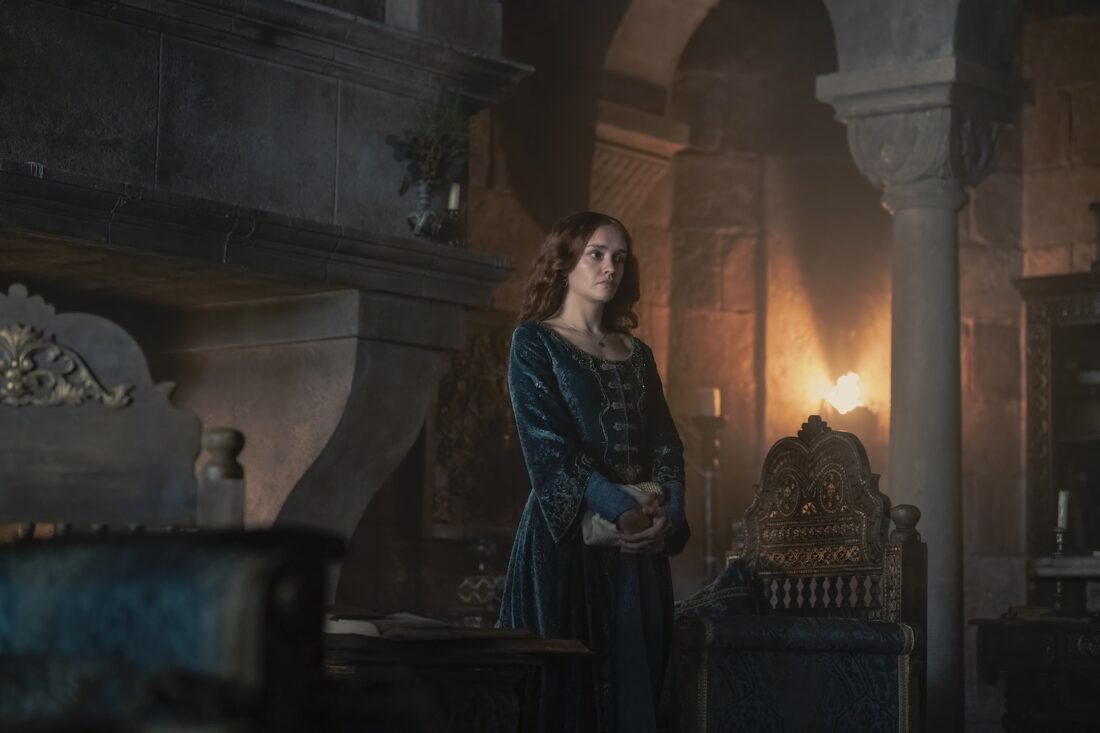
This episode sees Alicent (Olivia Cooke) taking “moon tea,” an in-world abortifacient brewed from tansy root. It’s unclear if this is because she knows that she is pregnant with Cole’s child or if she is merely taking precautions against the possibility, but the resulting pain causes her to miss Aegon’s council meeting. We do get an update on her itinerary after her meeting with Rhaenyra last episode: She appears to be searching out Viserys’ books, looking for more info on the Prince That Was Promised and the Song of Ice and Fire.
Larys (Matthew Needham) confronts her about her absence, dripping with innuendo suggesting he knows about Alicent’s affair and perhaps tinged with jealousy given his own sexual desires (which Alicent briefly capitulated to at the end of last season). But he pivots to a probing line of question that implies that he has surmised Alicent’s own doubts about her original interpretation of Viserys’ intentions for succession. He may, through his vast spy network, even know that she met with Rhaenyra.
Larys, of course, has his own motivations, first and foremost of which is to rise and survive. He is not quite like his rhyming Game of Thrones counterpart, Varys, insofar as he is nobly born and does possess lands and titles. But those lands include Harrenhal, where he is despised by his great-uncle and he may also possess an understanding that being granted Harrenhal as a seat is a fragile and hollow achievement at best. So in that regard, he is a free agent. Gyldayn has little to say about Larys during the events of this first half of season 2, so I would not be surprised to find that the show has given him some ulterior motives to further pressure Alicent.
Alicent’s defense against Larys’ inquiry ends in her saying that “Rhaenyra’s supporters will believe what they wish and so will Aegon’s. The war will be fought, many will die, and the victor will eventually ascend the throne. The significance of Viserys’ intentions died with him.” It feels like a pretty spot-on articulation of her general response to her meeting with Rhaenyra last episode. She believes herself to be powerless to stop what is to come, and so she is simultaneously attempting to figure out if Rhaenyra’s assertion is true (and that she herself was wrong), while also leaning back on her absolute lack of ability to stop the war.
And I am not convinced that she is wrong in this assessment. Alicent does have more power than she thinks she does, it’s true. Her berating of Aegon in this episode helps spur him to join the battle at Rook’s Rest which, in turn, may utterly alter the course of the war. But it’s also true both that she can’t stop the Green Council (especially Aemond and Cole) from backing down on Aegon’s claim and that even before she believed that Viserys had changed his mind, her own father had put the coup in motion. Finally, Larys is right, in this scene, when he notes that even uncontested, Rhaenyra’s succession might have started a civil war anyway.
Alicent Hightower isn’t a character with a spine of steel, nor is she fully aware of her own ability to influence the world around. She’s not so much bought in on the good of the patriarchy as she cannot imagine who she might be without it. But she’s never been more vulnerable on the show, and finds herself repeatedly facing and reiterating the fundamental truth that there is no world where she could single-handedly stop the Greens.
Dreams in the Witch House
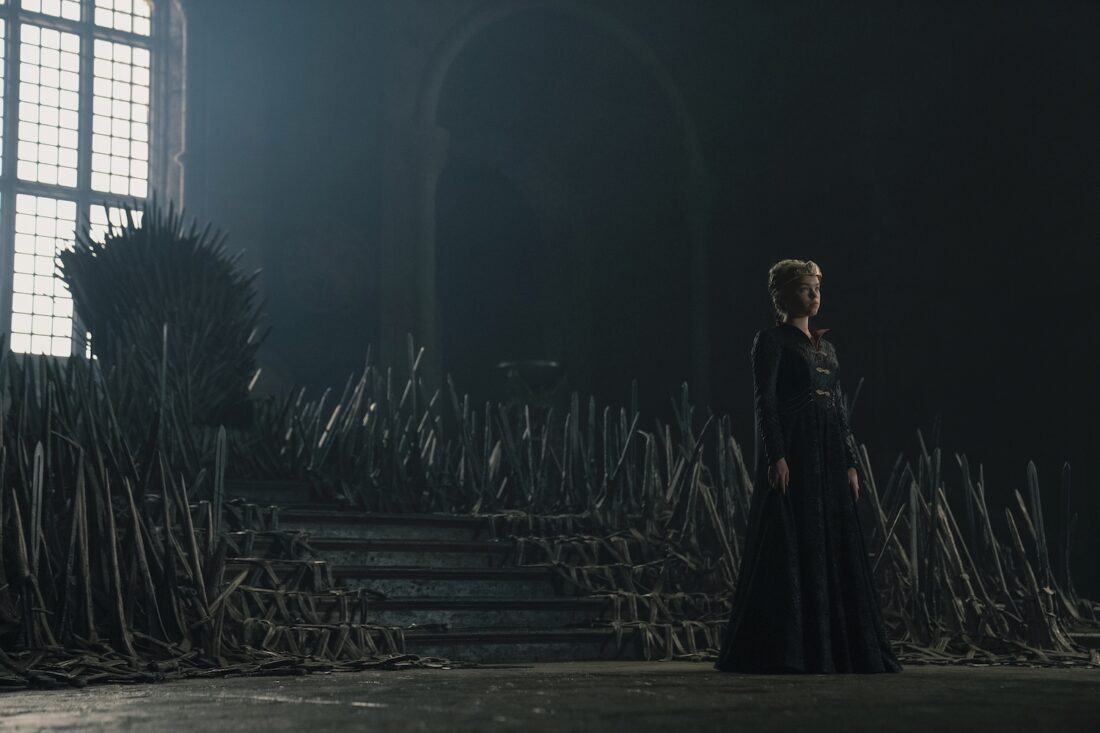
For the second episode in a row, we see Daemon Targaryen (Matt Smith) having creepy dreams where a younger version of his niece-wife, Rhaenyra (Milly Alcock), appears. He later follows a figure he believes to be Aemond only to discover it’s himself dressed as Aemond (we’ll talk a bit more about that in the Odds and Ends section, below). While many of these events might be the show playing up the first signs of that genetically inherited Targaryen madness, it feels far more likely that the show is leaning into the witchcraft and Old God magic that surrounds Harrenhal.
Key to this is Alys Rivers (Gayle Rankin) who cryptically implies that she’s taken over the Maester’s duties after the spirits of Harrenhal drove him mad. Of course, in the real world, there is a long history of both enshrining and disregarding femme-held medical traditions by calling it witchcraft and, in this regard, Westeros is not much different. Alys may simply be a knowledgeable midwife and herbalist, but Gyldayn notes that many who spent time at Harrenhal thought she was a witch. And, of course, the difference between our world and that of Westeros is that some forms of knowledge deemed “magical” in Westeros may really have supernatural power behind them.
Martin’s world is low-magic as far as fantasy settings go, but it is definitely not no-magic. And Harrenhal—even before the growing legends about being haunted by Black Harren’s ghost gained traction—has always been a witchy place. It sits on the North shore of the Gods Eye Lake and in the middle of the lake is an island known as the Isle of Faces—so named because of the massive grove of weirwood trees, all of which bear faces carved into them by the Children of the Forest. The Children are, of course, the diminutive, elf-like race of magically gifted shamans who inhabited Westeros before the First Men arrived. They practiced all sorts of nature magic, including divination, warging (like Bran in GoT), and, occasionally, cataclysmic spells like “the hammer of the waters,” which either flooded the Neck or smashed the Arm of Dorne into the Stepstones, depending on the evidence you look at. They could also, supposedly, astrally project using the weirwood trees as mounts, seeing through the eyes of the carved faces. The Isle of Faces is where the pact that ended the war between the First Men and the Children was made and where the order of Green Men was founded—Green Men being the term for humans who perform the same magical “greenseeing” as the Children. Maesters, Gyldayn included, sometimes surmise that, though the Green Men and the children were mostly destroyed when the Andals invaded Westeros thousands of years later, some Green Men and even some Children may still live, undisturbed on the Isle.
So that’s the most succinct history of Harrenhal’s adjacency to Westerosi witchcraft. Alys Rivers may be a Green Man or some hedge witch schooled in the Children’s magic. Gyldayn describes her as being about forty but looking much younger—unnaturally so—and, of course, Game of Thrones’ Melisandre famously used magic to hide her own longevity and advanced age. Certainly, it seems likely that Alys’ potions and salves are, at least partially, the source of Daemon’s hallucinations. We’ll see what the show does with her, moving forward, and how much it wants to make Martin’s witchy subtext into text.
DragonWatch: The Dance Begins
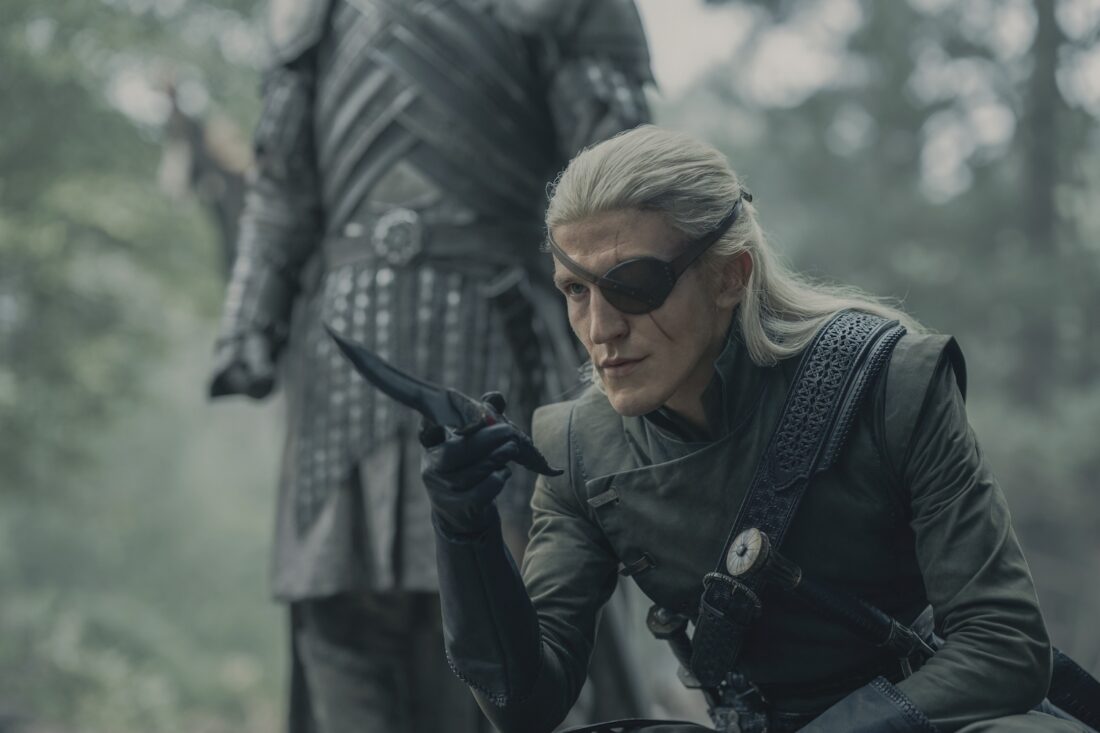
We got a bit of what war with dragons looks like during the fighting in the Stepstones in season one and there was, of course, the brief and tragic skirmish between Aemond on Vhagar and Lucerys on Arrax in the finale. But this episode shows us what dragons fighting dragons really looks like and the show nailed it, both from a VFX perspective and in terms of dramatic stakes. There are also some neat, general dragon details in this episode. The fact that they burn from their wounds either when they die or are gravely injured is a neat touch. That fire must come from somewhere inside them. Also, in Martin’s text, dragons have black bones and black blood due to an unusually high iron content (it’s why dragonbone is such a strong material). The shot of Sunfyre’s blood falling onto some soldiers and scalding them is a fun little detail since Martin often notes that dragons run supernaturally hot.
But let’s talk about the dragons involved in the Battle of Rook’s Rest.
Vhagar — The “hoary old bitch” has been featured plenty before, but we get to see her in battle during this episode. Named, like Balerion and Meraxes, for one of the gods of Old Valyria, she’s by far the oldest and largest of the dragons in this era of history. She was born on Dragonstone 52 years before Aegon’s conquest, which makes her 181 years old—the second oldest dragon in recorded history. She was originally ridden by Visenya, Aegon I’s more dour and bellicose sister-wife—the mother of Maegor the Cruel and the original wielded of Daemon’s sword, Dark Sister. She was ridden by Baelon Targaryen, Viserys and Daemon’s (and possibly Ulf’s) father before going feral for a period after his sudden death. Years later, she bonded with Laena Velaryon, Rhaenys and Corlys’ daughter (and Daemon’s second wife) until her death. The show rewrote Laena’s death to be a self-immolation with Vhagar as the tool. The show also showed us the moment when Aemond claimed her, perhaps denying Rhaena Velaryon a chance to try and bond down the line.
In F&B, Vhagar is described as bronze with green highlights and green eyes. The show has opted to more or less reverse those colors, giving her green scales with bronze horns, talons, and wingtips. The show has made her overall design reflective of her age. She has a huge, iguana-like wattle, her horns are tiny stunted spikes around her crown—almost like hair that has gotten thin and wispy in her dotage. And she’s huge, twice the size of Caraxes and Meleys—the two largest dragons currently ridden on the Blacks’ side. Both the show and the books treat Vhagar as some sort of unstoppable kaiju—the terrifying grandmother of the brood who, prior to the Dance, was the only battle-tested dragon other than Caraxes. The show also seems to be going with the narrative that her years as a feral dragon have made her ornery and slightly unpredictable. She’s my absolute favorite. She should be your favorite too.
Sunfyre — King Aegon II’s dragon is the youngest of the three combatants. Their name obviously is a reference to their coloration with the “y” in “fyre” being a common spelling for “fire” in dragon names (Dreamfyre being Queen Helaena’s dragon). Martin never discloses when, precisely, Sunfyre is born, but mentions that they were quite young when Aegon bonded with them in 120 AC, nine in-world years before tonight’s episode. It is overwhelmingly likely that Aegon is Sunfyre’s only bonded rider. According to Archmaester Gyldayn, they’re remembered as the most beautiful dragon to have ever lived, with bright golden scales and pale pink wing membranes. The show gave us an unfinalized version of Sunfyre last year (they’re one of the dragons hanging out on Driftmark in S1, Ep. 7) and seems to have greatly upped the saturation in the redesign. They do, indeed, glitter in the sunlight now.
The show has also given them one of the more expressively “cute” faces and the mutual smile that Aegon and Sunfyre give one another in the montage leading up to the battle is both deeply endearing and the happiest we have ever seen Aegon look. Of all the dragons we’ve seen, Sunfyre is the least threatening looking, the most dog-like. And that mien proves true; Sunfyre is not combat tested, and relatively weak. They are a reflection of Aegon himself and unable to stand up to their opponent (arguably their opponents, as Aemond, on Vhagar, has a notable lack of interest in sparing his brother or his brother’s dragon). We’ll see how the show handles the design of Sunfyre’s maiming at episode’s end (you’ll note the dragon, despite having a maimed wing and deep rents across their neck and chest, is still breathing by episode’s end).
Meleys — This episode bids a final farewell to Meleys, the Red Queen. Martin never explain the meaning of her name but, given that the dragon was named after David J. Peterson had done a huge amount of work in creating High Valyrian, we can safely assume that it’s derivative of the Valyrian word, mele, which mostly means “red” but can also refer to a number of dark, warm tones. We don’t get a birthplace or precise birthdate for Meleys in F&B, but we know she was an adult and the fastest dragon alive in 75 AC, making her somewhere north of 52 years old. She’s had two recorded riders, Princess Rhaenys and her aunt Alyssa Targaryen (more on that in the Odds and Ends section). The book describes Meleys as having scarlet scales, pink wing membranes and copper-colored horns and claws. The show has kept the majority of those notes and also given her a larger and spikier number of horns than other dragons, probably to simulate a crown that might have inspired the “queen” part of her nickname.
It’s unclear if Meleys was battle-tested prior to this conflict—other than her escape from the Dragonpit in S1, Ep. 9 (an invention of the show), we don’t get any specific battles she’s been involved in. That said, we know that Alyssa and Rhaenys are both martially inclined and perhaps took her through extensive training. We also know that she is one of the most frequently ridden dragons in Westerosi history. Both Alyssa and Rhaenys were avid riders—with Alyssa taking the infant Viserys and the infant Daemon for rides with her and Rhaenys riding Meleys to her own wedding—so Meleys is well traveled and among the most used to bearing a rider and taking commands. In the show, Rhaenys also, curiously, says “we’re off to battle again old girl.” It’s unclear what this refers to, though it’s possible that the show is claiming that Rhaenys fought (off-screen) in the Stepstones It’s also possible that this just refers to the time that Rhaenys and Meleys have spent patrolling the Gullet since the end of season 1. Alternatively, it might just be an acknowledgement that Rhaenys has been fighting for legitimacy her entire life and this is just one more battle, albeit a more literal one. Meleys and her rider are both killed this episode, felled by the older, larger Vhagar.
A Farewell to the Queen Who Never Was
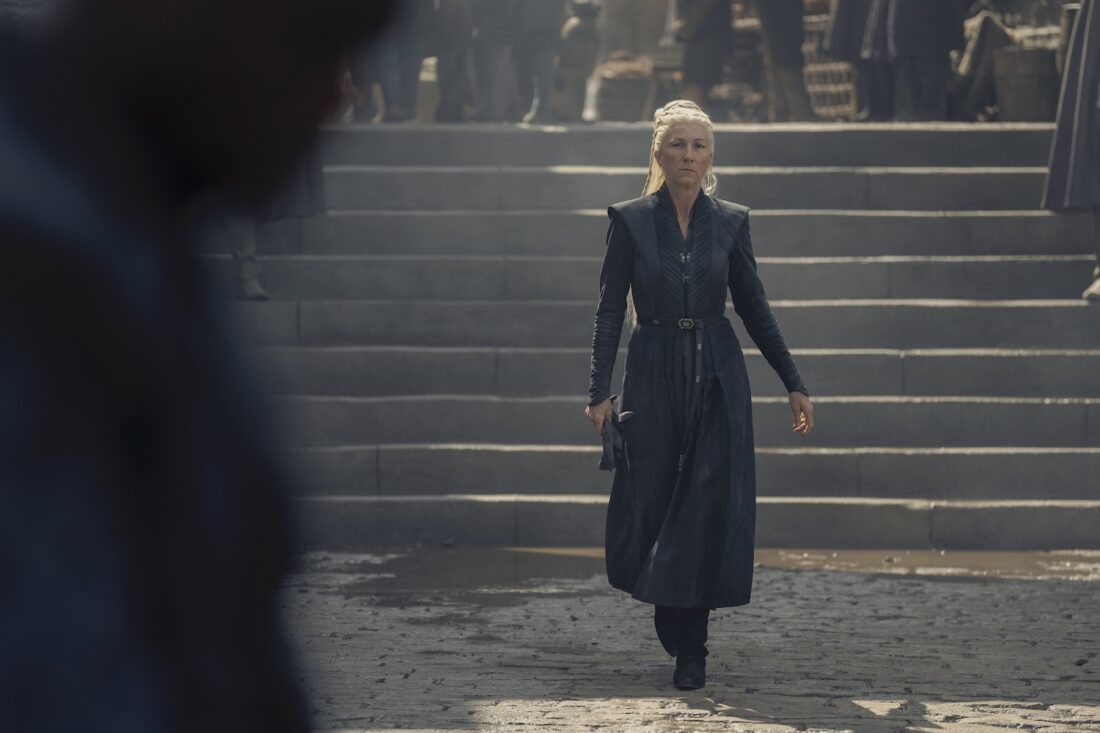
During the excellent montage that precedes the Battle of Rook’s Rest, Rhaenyra looks at the skull of Meraxes in the Dragonstone library. You can see the shattered eye socket where the great beast was felled by a Dornish scorpion bolt. The death of Meraxes was the last time a Targaryen princess died in battle. That princess, Aegon the Conqueror’s beloved sister-wife, was also named Rhaenys. The shot is a great bit of grim foreshadowing for the death of this Princess Rhaenys at episode’s end.
HotD, even more than its source material, figures Princess Rhaenys as the voice of reason in the midst of the Targaryen civil war. She is the only person who both knows that Rhaenyra is setting herself up for a grotesque, uphill climb with regards to the realm accepting a woman as monarch and also among the few people who understand that Alicent has always sold herself short in acting as a tool of the lesser men around her. Book readers have been observing the way that the show has been doubling down on her sage counsel this season, the better to make her loss more catastrophic, specifically to the Blacks, but to proponents of peace and reason generally.
Eve Best played Rhaenys as steely, grim, and possessed of a quiet contempt that was obvious in all the scenes where the disappointing men of the show made fools of themselves. She also imbued her with a secret warmth, typically reserved for her husband, that spoke to a version of Rhaenys that did not have to be the Queen Who Never Was had fate played out differently. She has many great moments over the course of the last two seasons—her keen questioning of Rhaenyra and Alicent at various points in season one, her confrontation with the Greens at the coronation, her bristling with Daemon in episode one of this season—but among her best moments are her last.
Gyldayn tells us, of her final moments: “Princess Rhaenys made no attempt to flee. With a glad cry and a crack of her whip, she turned Meleys toward the foe” (Martin 434). Best plays it differently. There is no glad cry, just a heartbroken look of determination and sorrow as she turns back towards Rook’s Rest, knowing she can’t abandon Rhaenyra’s allies, even knowing it will likely mean her death. When she witnesses Meleys’ death, she purses her lips slightly and lets go of the reins, accepting that this is the end of the battle she has been fighting her entire life.
Odds and Ends
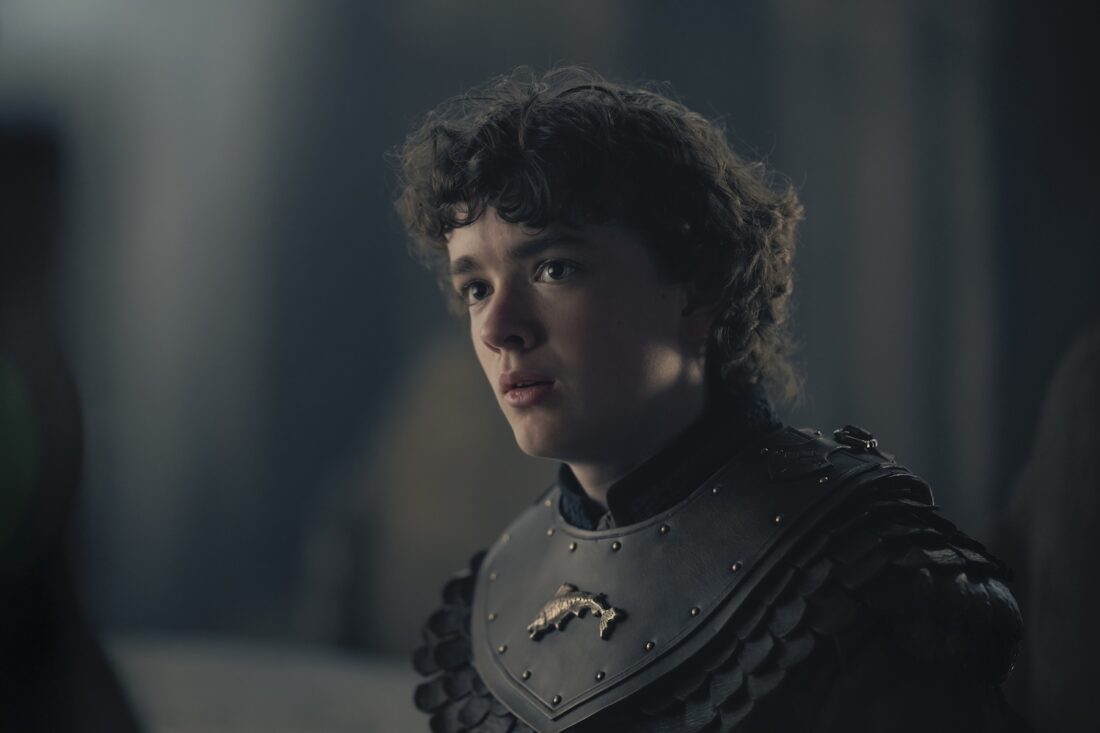
- The introduction of Oscar Tully (Archie Barnes) settles that the show has simplified the Tully family in this era and combined a bunch of characters. That’s probably for the best seeing as Martin named all the Tullys of this era after his favorite Muppets. Oscar, in both the show and the book, is the grandson of Grover Tully. In F&B, however, Oscar’s father, Elmo, is still alive. Additionally, Oscar has a brother, Kermit, who also turns up in the Riverlands muster. I feel like Condal et al. did the best job they could of picking out the Tullys whose names would not be too obviously Muppet-y to viewers. Personally though, I think Martin missed out on a grand opportunity to throw in a Telly Tully.
- When Alicent accepts the moon tea from Grand Maester Orwyle, she drops and shatters the carved stone dragon she gave Viserys as a girl. Shattered symbols of the past are everywhere this season, and no prop is taking more abuse than Viserys’ model of Old Valyria.
- In Ser Steffon’s absence, Ser Lorent Marbrand sits on Rhaenyra’s council. Like the Broomes, the Marbrands are a Westerland family, sworn to the Lannisters and likely declaring for Aegon. But Kingsguard knights swear an oath to disregard family loyalty in favor of service to the crown.
- Speaking of the Kingsguard, Aegon’s three drinking buddies who were named to the Kingsguard last episode are identified on IMDB now. They are Ser Martyn Reyne (Barney Fishwick)—a Westerland knight and ancestor to the Reynes who Tywin Lannister will later put to death for sedition in the event that results in the song, “The Rains of Castamere” (“rain” being a pun on “Reyne”)—Ser Leon Estermont (Ralph Davis)—a knight from one of the islands in the Stormlands and potential antecedent of Cassana Estermont, the wife of Steffon Baratheon and mother to King Robert, Stannis, and Renly—and Ser Eddard Waters (Tok Stephens) who is a nobly-born bastard from the Crownlands. They join the other two knights on the Green Kingsguard, Rickard Thorne (Vincent Regan)—from a Crownlander House that will eventually produce Ser Alliser Thorne, Jon Snow’s prickly superior officer in the Knight’s Watch—and Ser Willis Fell (who hasn’t been cast and is played by an uncredited, helmeted extra), a knight from a minor house in the Stormlands.
- Duskendale’s Dun Fort is rendered in the background of a scene. It’s great that a storied locale, relatively unimportant to this particular tale, still gets consideration, design, and delightful execution (I may have set an ASoIaF Dungeons & Dragons game in Duskendale so I’m a little biased). If TV shows are going to be ungodly expensive, let’s have that money show up in this level of detail.
- Cole executing Lord Gunthor Darklyn (Steven Pacey) follows in the grand tradition of GoT scenes where a nervous man in power has to execute an honorable or, at least, complicated prisoner who curses his name. Theon Greyjoy did it to Ser Rodrik Cassel in season 2 of the original series. Robb Stark did it to Rickard Karstark in season 3. Both of those are implicit mirrors of Ned Stark’s execution of Will, the Night’s Watch deserter in one of the earliest scenes of Game of Thrones’ premiere. Ned tells Bran that “the man who passes the sentence should swing the sword.” It’s a pithy truism on the necessary weight of stewardship. Ironically, Ned killing Will is one of the moments where the Westerosi turn a blind eye to the problem of the White Walkers.
- Lord Darklyn names Ser Criston “kingmaker.” Jasper Wylde (Paul Kennedy) later repeats it as a good thing. In the books, the epithet is a mark of shame. Martin vaguely implies that it has to do with the fact that Ser Criston literally crowns Aegon II at his coronation, but it becomes associated with the idea that Ser Criston is the organizing power behind the Greens. Though we know better, it would look from the outside that a man who first crowned a contested king and, within a week, ousted that king’s own grandfather as Hand, before leading an army to conquer the Crownlands, is a power-hungry social climber reaching beyond his station. Either way, you can bet that some of the vitriol is leveled as his being Dornish.
- Daemon sees himself dressed as Aemond in one of his Harrenhal dreams this week. The uncle-and-nephew/brothers-in-law (damn Targaryens!) are often treated as doubles of one another in the book. They are the two most personally dangerous and martially inclined members of each faction’s household; they currently both ride the largest dragon on each team (though Caraxes is about half the size of Vhagar). They are also both deeply troubled narcissists who feel unfairly overshadowed by their king-of-the-Seven-Kingdoms older brothers. They are also both coded as part of the “bad” Targaryen line—the part more disposed towards madness than greatness. This line is associated with Visenya Targaryen: Aemond rides Vhagar, her dragon, and Daemon wields her Valyrian steel sword, Dark Sister. Both the book and the show now have them hunting one another, sensing a rival they must destroy. The pairing even is even reflected in their names: they both have the standard Targaryen name “Aemon” with a “d” placed either at the beginning or end.
- In the book, Alyn and Addam’s mother is Marilda of Hull. She’s a badass wharf urchin who rises to become the owner of a small fleet of merchant vessels. She doesn’t have anything to do in Fire & Blood that is necessary to the main plot and most of her story happens about twenty years before the events of season 2, so I can understand why she has (likely) been cut from the show—but she’s cool and worth mentioning. She’s diminutive and was nicknamed “Mouse,” a name she eventually gave to her capital ship!
- Aegon speaking High Valyrian badly is a spot of much needed humor on the show. Also, it helps to signal the worthiness of Aemond. True Targaryens, in the context of the show, seem to know their ancestral tongue.
- Is Alys Rivers making weirwood paste? She certainly could be, given the coloration. Weirwood paste is the mind-altering and magic-strengthening substance that Bran is fed by the Three-Eyed Raven and his Children of the Forest attendants beyond the Wall. It’s made from crushed weirwood seeds and, possibly, the blood of a human/Children sacrifice. In the ASoIaF books, a popular fan theory has it that Jojen Reed (played by Thomas Brodie Sangster in the show) was killed by the Three-Eyed Raven and had his blood used to help Bran ascend.
- Ser Willem Blackwood (Jack Parry-Jones) represents a rare moment when the show has split, rather than combined characters. As Daemon comes out of his addled trip after sipping Alys Rivers’ concoction, we can hear Ser Willem say that “[he] rules his house as regent until [his] nephew Benjicot comes of age.” This is, of course, in reference to the (offscreen) death of Lord Samwell Blackwood during the Battle of the Burning Mill last episode. In the books, Benjicot Blackwood is eleven at this time and has no uncle Willem (He has a natural-born uncle, Rob Rivers, and an aunt, Alysanne Blackwood, who may still become important on the show). Benjicot becomes known as “Bloody Ben” for leading the Blackwood men to various victories during the Dance. He’s a minor character, but he stands out in Fire & Blood because he’s a bloodthirsty, deadly eleven-year-old boy and that’s precisely the sort of perverse mythmaking that Martin loves. So Willem seems to be a stand-in for Benjicot. After all, we saw him last in S1, Ep. 4, as a suitor to Rhaenyra (and then played by Alfie Todd), where he, aged about eleven, brutally murders the much more age-appropriate rival suitor Jerrel Bracken (Gabriel Scott), abruptly ending Rhaenyra’s reception of suitors at Storm’s End. Many fans assumed this was an aged-up Benjicot at the time, given the similar image of a murderous little boy. But we know the show’s full plan now. They took all of Bloody Ben’s child-fury and gave it to an invented uncle Willem, who will now lead Blackwood’s armies. It’s probably all been in the service of not representing a literal child leading an army into battle—an image that would probably either play as too silly or too uncomfortable on the show. For fans of Bella Ramsey’s Lyanna Mormont, remember that the original show was careful to make that child general more of strategist, leading from behind and was very clear that she was (tragically) hopelessly outmatched when it came to combat. Bloody Ben, by contrast, is known for acts of slaughter rather than keen insight and valor.
- Another nice bit of minor character-building to remind us that Anthony Flanagan’s Ser Steffon Darklyn is the son of the beheaded Lord Gunthor. In the book, Gunthor Darklyn is Ser Steffon’s nephew (the new Lord of Duskendale) and his beheaded Lord father is not given a first name. Given that the book’s Gunthor Darklyn doesn’t do anything meaningful, the show just gave the one with lines the name and has left the original Gunthor uncast and unmentioned.
- Rhaenyra is taking her legacy seriously this episode. Emboldened by Alicent’s confirmation that Viserys’ actual dying thoughts were about the prophecy, she finally shares the Song of Ice and Fire with Jacaerys.
- Rhaenys wears an absolutely gorgeous iron kokoshnik (wait, is a kokoshnik made of metal just a diadem?) into battle. The choice to use the undeniably sexiest piece of headgear as a decorative helmet is great. Obviously, the costume design on the show has always been top-notch, but we should all be wearing filigreed iron kokoshniks this year.
- Meleys, Rhaenys’ deceased dragon, was originally ridden by Alyssa Targryan, Viserys and Daemon’s mother. Caraxes, Daemon’s dragon, was originally ridden by Rhaenys’ father, Aemon. The show did a great job, throughout this season, of pairing Daemon and Rhaenys, both as Targaryens who bonded with the dragons of one another’s parents, and as Targaryen heirs who were passed over for the throne. I didn’t really catch on until this episode, but I’m deeply enthused by that parallelism which the show never mentions outright, but clearly is aware of. Now that Rhaenys is gone, the show can focus, full time, on doubling Daemon and Aemond.
In Conclusion
I thought the Battle of Rook’s Rest would be much later in the season but, it seems, the show is hell-bent on shaking things up at the midway point. This was really the first time HotD made good on its promise to be a show that focused on the dragons to a degree that Game of Thrones was never able to. And it did not disappoint. Traditionally, GoT has had to be a bit sparing (until the final couple seasons at least) with how they staged their battles, especially the ones that involved dragons, but now we’re finally experiencing these epic showdowns in their full glory (and horror). It’s great. Absolutely great.
But what did you think? Let me know your thoughts on the dragons, the battles, the fashion choices, and anything else of note in the comments below…


